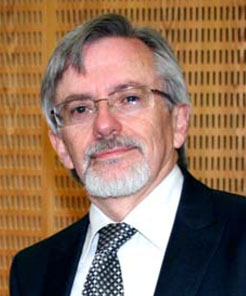Nova in M31 discovered by Bromsgrove amateur
2016 January 26
 On 2015 November 22 George Carey of Bromsgrove Astronomical Society (right), was co-discoverer with K. Hornoch (Astronomical Institute, Ondrejov, Czech Republic), of a nova in Messier 31 (Andromeda Galaxy). Nick James and Denis Buczynski, on behalf of the UK Nova/Supernova patrol and The Astronomer magazine, investigated George’s report and the discovery claim, in conjunction with that of Hornock, appeared in The Astronomer’s Telegram 8327.
On 2015 November 22 George Carey of Bromsgrove Astronomical Society (right), was co-discoverer with K. Hornoch (Astronomical Institute, Ondrejov, Czech Republic), of a nova in Messier 31 (Andromeda Galaxy). Nick James and Denis Buczynski, on behalf of the UK Nova/Supernova patrol and The Astronomer magazine, investigated George’s report and the discovery claim, in conjunction with that of Hornock, appeared in The Astronomer’s Telegram 8327.
Discoveries were on a co-added 900s R-band CCD frame taken on 2015 Nov 22.718 UT with the 0.65m telescope at Ondrejov (Hornock) and independently on two 600s luminance filter CCD frames taken on Nov 22.756 UT with the 0.20m telescope at Bromsgrove (Figure 2) by George Carey. The Central Bureau’s WWW site allows posting of suspects and this was initially designated PNV J00433852+4128026. David Bishop also gave it a provisional name of Nova M31 2015-11c, yet to be confirmed. The object, of approximate magnitude 17, is located at R.A.= 0h 43m 38s.52, Dec= +41° 28′ 02″.6 (equinox 2000.0), which is 610.1″ east and 714.1″ north of the centre of M31.
The patrol coordinator met with George Carey recently during a visit to Bromsgrove Astronomical Society to give a talk about astronomical transients. He had already come close to an earlier M31 nova discovery being just hours after the initial announcement. It was obvious his thoroughly planned M31 patrol stood a good chance of yielding more extra-galactic novae.
The telescope is a homemade carbon fibre tube Newtonian reflector with an 8″ (200mm) mirror. The primary is a top class Carl Zambuto mirror (1/26th wave) with a 1/30th wave secondary by Antares Optics. Details of construction can be found at http://geoastro.co.uk/zambuto1.htm.
George uses a QSI 683 CCD camera with a Lodestar for guiding. For the nova search he takes 10 minute exposures with the luminance filter. The field of view is 38×51 arcminutes, so to cover the bulk of M31 the mount moves to four different positions with the core of the galaxy positioned in a corner of each frame. The process is repeated so that two images are obtained for each position. A small image shift with each pair of images helps to eliminate hot pixels and cosmic ray artefacts. Operation of the equipment takes place from the warmth of the study via a network link.
After calibration with flat, dark and bias frames the two images plus a reference image from a previous night are aligned with RegiStar, plate solved with Pinpoint and then the asteroid search facility in Pinpoint is used to ‘blink’ the images. A candidate nova will then appear twice in the blink sequence whereas artefacts will blink only once. The discovered nova popped out very clearly.
Our sincere congratulations to George and we wish him many further successes in his study of Messier 31.
Guy M. Hurst, Coordinator, UK Nova/Supernova Patrol
| The British Astronomical Association supports amateur astronomers around the UK and the rest of the world. Find out more about the BAA or join us. |
